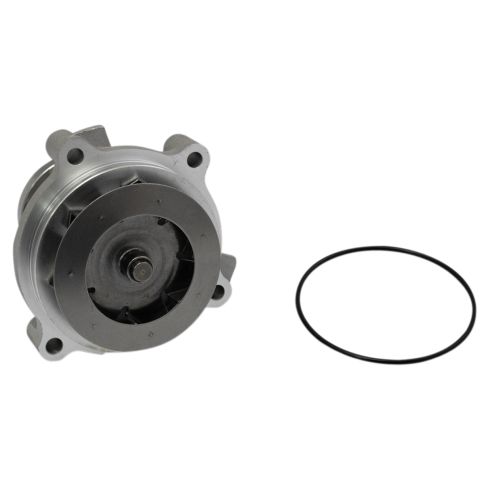Replaces
2009 Ford Expedition V8 5.4L with 30mm Hub Engine Water Pump TRQ WPA07168
Similar Items
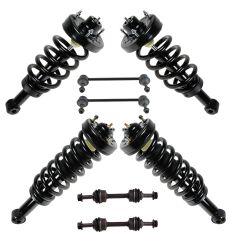
Replaces 2007-13 Ford Expedition Lincoln Navigator Front & Rear 8 Piece Suspension Kit TRQ SCA67128
$554.95
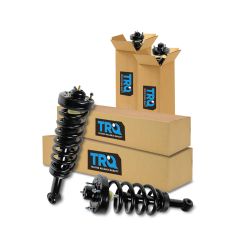
Replaces 2007-13 Ford Expedition Lincoln Navigator Front & Rear 4 Piece Strut & Spring Assembly Set TRQ SCA57061
$519.95
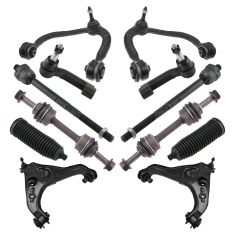
Replaces Ford Lincoln Front 12 Piece Steering & Suspension Kit TRQ PSA56595
$474.95
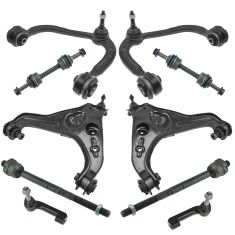
Replaces Ford Lincoln Front 10 Piece Steering & Suspension Kit TRQ PSA70016
$454.95
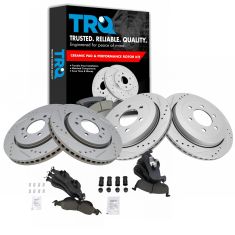
Replaces 2007-09 Ford Expedition Lincoln Navigator Front & Rear Ceramic Premium G-Coated Performance Brake Pad & Rotor Kit TRQ Performance BKA18635
$454.95
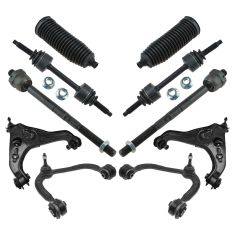
Replaces Ford Lincoln Front 10 Piece Steering & Suspension Kit TRQ PSA27560
$439.95
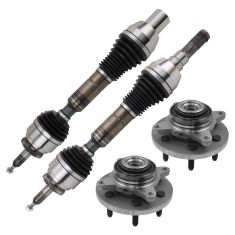
Replaces 2007-10 Ford Expedition Lincoln Navigator Front 4 Piece Drivetrain Kit TRQ PSA77883
$439.95
Part Details
- No
- Aluminum
- 4
- No
- 2
- No
- Standard
- Cold Rolled Steel
- No
- 4
- 7
- 80 mm
- 3.43 in
- No
Specifications
- with 30mm Hub
- V8 5.4L
About TRQ:
TRQ is a trusted brand dedicated to making every repair a success story by combining premium parts with easy installation. Each TRQ part is engineered by a team of automotive experts to meet or exceed OEM standards, delivering enhanced performance and maximum longevity. With rigorous in-house testing, the brand ensures superior fit and function across every product line. TRQ also provides customers with best-in-class, step-by-step installation videos—so you can complete repairs with confidence, whether you're a first-time DIYer or an industry professional.
Attention California Customers:
![]() WARNING: This product can expose you to chemicals including Lead and Lead Compounds, which are known to the State of California to cause cancer, and birth defects or other reproductive harm. For more information, go to www.P65Warnings.ca.gov.
WARNING: This product can expose you to chemicals including Lead and Lead Compounds, which are known to the State of California to cause cancer, and birth defects or other reproductive harm. For more information, go to www.P65Warnings.ca.gov.
Lifetime Warranty
This item is backed by our limited lifetime warranty. In the event that this item should fail due to manufacturing defects during intended use, we will replace the part free of charge. This warranty covers the cost of the part only.
FREE Shipping is standard on orders shipped to the lower 48 States (Contiguous United States). Standard shipping charges apply to Hawaii and Alaska.
Shipping is not available to a P.O. Box, APO/FPO/DPO addresses, US Territories, or Canada for this item.
Expedited is available on checkout to the United States, excluding Alaska, Hawaii.
Final shipping costs are available at checkout.





Created on:
Tools used
- Put a catch pan under the radiator Use a wrench to open the valve and drain the radiator Replace the cap Put the catch pan under the middle front of the engine
- Insert the ratchet into the tensioner Push clockwise on the tensioner and remove the belt from the alternator Slowly release back on the tensioner Remove the belt from the water pump pulley and set it aside
- Place a belt wrench on the cooling fan pulley Use an adjustable wrench on the large bolt holding the fan Remove the fan
- Place the belt wrench on the water pump pulley Remove the four 10mm bolts securing the pulley Use a flat blade screwdriver to pry from the back of the water pump pulley. Turn it and continue to pry till it comes off Remove the four 10mm bolts securing the water pump Use a hammer to hit the side of the water pump shaft. When it starts to separate use a flat blade screwdriver to help get the pump free Use a sponge and wire brush to clean up the area
- Put penetrating oil on the water pump Line it up and push it into place Replace the four 10mm bolts. Hand tighten each of them and work your way around. Tighten incrementally. Then tighten them to 19ft/lbs Replace the pulley and replace the four 10mm bolts. Tighten to 20ft/lbs Turn the cooling fan back in to place and replace the bolt Replace the belt around the crankshaft Loosen the tensioner Put the belt over the alternator Tighten the tensioner Make sure the belt is properly in place
- Fill the truck back up with antifreeze Start the vehicle to circulate the antifreeze Fill the antifreeze back to the line Drive the vehicle Let it cool then fill to the line again
Brought to you by 1AAuto.com, your source for quality replacement parts and the best service on the internet.
Hi, I'm Mike Green. I'm one of the owners of 1A Auto. I want to help you save time and money repairing and maintaining your vehicle. I'm going to use my 20 plus years of experience restoring and repairing cars and trucks like this to show you the correct way to install parts from 1A Auto.com. The right parts installed correctly that's going to save you time and money. Thank you and enjoy the video.
In this video we're going to show you water pump replacement on this 2003 F250. This truck has the 5.4 liter gas V8. This procedure is the same for a lot of Ford trucks and SUVs as well as vans with the 4.6 liter and the 5.4 liter V8 engines. The tools you'll need for this job are a large adjustable wrench, a catch pan, half- inch drive breaker bar or a ratchet with a pipe for leverage that's to get the serpentine belt off, a belt wrench, a 10-mm socket with a ratchet and extension, a hammer, a large flat wedge screwdriver, small wire brush, rags, or a sponge or paper towels, and two or three gallons of fresh antifreeze or coolant, and also as anybody knows on these trucks if you have a stool you'll need it to stand on to reach over that big grill.
Okay, looking at the engine compartment right here the fan is attached to a pulley that is attached to your water pump. So indicators that your water pump is your problem is when your vehicle is running you will smell the kind of a sweet smell of the coolant. You'll also probably see some steam coming from this area of the engine and then underneath you may see some water. Actually my truck's already leaked it all out so there's no water underneath here but you may see some water or green coolant on the ground underneath your truck and then as you look up at the bottom of the engine okay, you can see that the front bottom of my engine is damp. It is has coolant on it. I'll zoom in here a little bit to see the coolant right there dripping off the front of the engine. That means that the coolant is leaking out of the water pump.
Okay, so what we're actually going to do is right under here this is my radiator and this is my drain. I'm going to use a wrench, put a catch pan underneath, open this up, and drain. You don't have to drain all the coolant out but you want to drain some of the coolant out of the radiator to bring the level down some. Okay, so now that is tightened up that drain and I just position my pan underneath the middle of the front of the engine. Okay, now you're going to remove your serpentine belt. I'm taking a half-inch drive ratchet, inserting it into my tensioner and I put the pipe on that helps me get leverage. Push clockwise on the tensioner and then you can slide the belt right off of the alternator and then slowly release back on the tensioner and you take your ratchet and pipe off and you can take your belt and then just kind of remove it from that side and just pull it over here.
Okay, with the belt out of way it's very easy to see right there is your weep hole so you look for coolant coming up and out of there. And even in this shot it appears to be dry. That's only because my truck was so low on coolant because the coolant leaked out of the water pump so quickly. You can see how it stained, the rust-colored stain. That water pump is aluminum so that rust-colored stain basically indicates some coolant came up out of the cast iron block and deposited some rust so we can be 100% sure now that the water pump is the problem.
I need to remove my cooling fan. I've got a belt wrench and you want to put the belt down around the pulley. Now you can see here I've got my belt wrench on. I'm using it. I'm actually pressing it against the alternator to hold it in place. I'm going to put my large adjustable wrench down in there and a large and remove a large bolt that holds the fan. Once you have that loosened up then you basically can just kind of spin the fan right off. I'm just going to want to let the fan rest right in there.
Now using a 10-mm socket with a ratchet remove the two bolts that hold the pulley and we're just going to fast forward this so you're doing the same thing. Use that belt wrench around the water pump pulley, hold it in place, and then the 10mm socket and ratchet. Remove those four bolts that hold the pulley in place. Okay, here you can see I just disconnected that up radiator hose to give you a better view. You don't have to do that but use a flat blade screwdriver and just pry against the water pump, keep turning the pulley a few degrees, and keep prying until it comes off. Now your water pump's held on by four 10mm bolts. You can see one and two, there's the third one here, and one underneath over here that you can't really see. I got that one underneath first.
I'm going to fast forward as I remove the four bolts that hold the water pump in place. These four bolts come out fairly easily once you get them started with a wrench. After a couple turns they basically come right out with your fingers. Okay, now what you want to do is take a good-sized hammer and basically hit the side of the water pump shaft and you can see it's starting to move back and forth. Once you get it and actually if you look just below the radiator hose you'll see a little crack opening up. Once you get it to move quite a bit then use a screwdriver, force it into the crack, and then hit the opposite side.
Okay, and then I'll move back and forth between hitting one side and the screwdriver until the pump comes out. Okay, so I'm moving it back and forth, changing position of the screwdriver. You can see the pump comes out and some more antifreeze will drain out of your engine. Take a nice absorbent sponge and try and just kind of sop of some of the coolant down here and take a wire brush and just carefully clean it up a little bit. Just take your sponge and just kind of wipe out and make sure you don't leave anything in there. New pump. Got my O-ring installed. I put some penetrating oil on it so it'll slide in nicely and I'm going to have my weep hole up and that's pretty much well in place. All right. The bolt's in. Okay, I'm going to fast forward here. This is kind of a long process this part of it. You want to put each bolt in by hand first and you want to basically push in firmly on the pump and get all the bolts kind of hand tight. You need to make sure that you force your pump in nice and straight so basically get all the bolts in by hand first, then tighten one of them a few turns. Go to the opposite one, tighten that a few turns, one of the other ones, tighten a few turns, opposite one a few turns until you have all of the bolts basically snug. Now we're going to tighten these bolts to 19 foot pounds. I'm going to start with the top one and then go to the bottom one. Okay, I'm going to fast forward through quite a bit of the reassembly here.
Put that pulley back on, start all four bolts. When I put it on I actually put one bolt through, get that one started, get the pulley in place, then start the other three bolts, then you can put your belt wrench back on the opposite way. Again, put it against the alternator so it holds it in place and tighten up the bolts. You want to have them probably about 20-foot pounds. They don't have to be extremely tight, just on there snug. Don't over tighten them because you don't want to stretch them or break them.
Now re-install the cooling fan. You basically lift it up into place, push it onto the shaft, and just keep turning it slowly until you get it on there. Be careful not to cross-thread it. Get it into place. Then use your large adjustable wrench with the belt wrench and tighten it up. I'll take our belt and make sure it's still down around the crank shaft. Okay, take it down and around this pulley here. Okay, now it's all on there with the exception of the alternator. The ratchet put it in the tensioner, the pipe, the ratchet and pipe. Pull the tensioner over and put the belt over the alternator. And then release the ratchet and make sure your belts all on there.
We're going to refill the anti-freeze, got a filter in there. Your minimum cold fill line is right here. Depending on how much you drained your radiator it's probably going to take 2 -3 gallons. Make sure its properly mixed fluid. As you can see I filled it up and if you really watched close it is kind of draining down. I'm going to start the engine for just a minute and get that fluid circulating through the truck a little bit. Ok I'll get it back up to that minimum line. We'll drive it around a little bit. Let it cool down and check. And fill as needed.
So now you can see with the truck idling and up to temperature. No leaks underneath nice and dry. And you can see our fluid went down some we'll shut it off let it cool off, recheck that fluid and go from there.
We hope this helps you out. Brought to you by www.1AAuto.com, your source for quality replacement parts and the best service on the internet. Please feel free to call us toll-free, 888-844-3393. We're the company that's here you on the internet and in person.
Tools used
- Have a drain pan ready Loosen the white 8mm nut on the radiator drain plug Close the valve
- Disconnect the two breather hoses Loosen the two hose clamps with a flat blade screwdriver Remove the air intake
- Disconnect the radiator bottle hose Remove the two 10mm bolts from the radiator bottle Remove the radiator bottle Remove the 8mm bolt from the power steering reservoir Move the power steering reservoir to the side
- Remove the 10mm bolt on either end of the radiator fan shroud Slide back the hose clamp Disconnect the coolant hose from the radiator Pull up and remove the fan shroud
- Disconnect the fan connector Remove the 8mm bolt from the fan sensor Move the sensor off to the side Hold the water pump pulley with a wrench Remove the 36mm nut from the fan clutch with a thin wrench and bar for leverage Spin the fan clutch off
- Remove the four 10mm bolts from the water pump pulley Remove the pulley
- Familiarize yourself with the route of the serpentine belt Insert the 3/8 inch drive ratchet into the tensioner Turn the tensioner clockwise to loosen the belt Pull the belt off the alternator Release the tensioner Pull the belt off by hand
- Have a drain pan ready Remove the four 13mm bolts from the water pump Tap the pump with a hammer to break it free Loosen the pump and let the coolant drain
- Clean off the splines with a wire brush and cleaner Insert the water pump into place Tighten the four 13mm bolts to the water pump Torque the bolts to 18 foot-pounds
- Insert the pulley to the engine Hand-tighten the bolts to the pulley Tighten the bolts to the pulley
- Bring it around the idler pulley Bring it around the A/C Pulley Loop the belt around the crank pulley Bring it around the water pump Bring it around the power steering pulley Bring it around the idler pulley Bring it around the belt tensioner Pull the tensioner clockwise with the 3/8 inch ratchet Pull the belt over the alternator Release the tensioner Torque the water pump pulley bolts to 18 foot-pounds
- Install the fan to the water pump shaft Hold the water pump pulley in place Tighten the nut with a 36mm wrench Connect the sensor Tighten the 10mm bolt to the lead
- Insert the shroud into place Tighten the 10mm bolts to the shroud Connect the coolant hose Close the hose clamp
- Tighten the 8mm bolt to the power steering reservoir Tighten the 10mm bolts to the coolant
- Connect the air intake Tighten the hose clamps Connect the PCV and breather hoses
- Tighten the 10mm bolts to the coolant bottle Connect the hose to the radiator Fill the coolant and radiator to the appropriate level Run the engine
Hi, I'm Mike from 1AAuto. We've been selling auto parts for over 30 years! We're dedicated to delivering quality auto parts, expert customer service, and fast and free shipping, all backed by our 100% satisfaction guarantee. We've created thousands of videos to help you install our parts with confidence. That saves you time and money, so visit us at 1AAuto.com, your trusted source for quality auto parts.
In the driver's side front of your radiator, there's a drain. You can see the little drain hole here. There's usually an 8 millimeter nut here, which you can loosen. There's also an 8 millimeter Allen inside. Drain that. Loosen it up, and your fluid will start draining out.
We've actually already drained the fluid, so we're just kind of going through the motion. You're not going to see any fluid drain out, but have a drain pan underneath to collect all your coolant. While the radiator's draining, I'll remove the radiator cap, which will allow air in and the fluid to come out faster. Once your coolant's done draining, close the valve back up.
Remove your air intake tube. There are two fittings. You just press the green tab to the side, and pull them off. Again, the green tab. Pull it up and off, and then loosen your two band clamps, and pull the tube out with a flat blade screwdriver. Remove the hose from the radiator fill, and then remove the two 10 millimeter bolts that hold the bottle on. There's also a wiring harness clip back here that you'll have to pull off.
Remove the 8 millimeter bolt that holds the power steering reservoir in place. Then just pull it up and kind of set it off to the side. A 10 millimeter bolt holds the upper radiator shroud on here, and there's one right on the other side as well. We'll remove those. Use a good pair of pliers. Squeeze this clamp, and this little tab will actually lock it open. That's all right. Then twist the radiator hose and pull it off. Set it back as well. Then you can kind of pull up and back towards the engine, and pull your upper shroud up and off.
Disconnect the lead. There's just a tab right here. Push down with your thumb and separate it, and then remove this 8 millimeter bolt. Use an 8 millimeter socket with a ratchet and extension to help you out. That comes out, and just kind of pull this out. You actually can swing it off to the side to make it easier to get at your fan clutch. Once you get to this point, there are special tools designed specifically for getting the fan clutch off.
Now we need to remove the fan clutch, which is this large 36 millimeter nut here. Basically, you want to use a wrench to hold on to the pulley. You can see this wrench goes down, and it goes over the bolts. I can now hold that pulley like that. Then I have a 36 millimeter wrench that's a little thinner that fits down over. I can put a bar, for more leverage, on there. Usually, once it loosens up, you can see, now, that the fan clutch is spinning right off.
Before you take your belt off, just note how it's routed up over the alternator, under this idler, around your power steering, up over the water pump, and around the crank, up over the tensioner, and then back down around your AC, and back up and around.
We'll remove these four 10 millimeter bolts on the water pump pulley. You don't want to put the wrench on like this, because most likely it will just spin the pulley. If you put the wrench so the handle is over the center, you'll have less leverage on the pulley, and the bolts should come loose. You can leave one in just to keep the pulley in place till you take the belt off. Half inch ratchet handle in the square hole in your tensioner. Put the handle in, push down, and just take the belt off, and then slowly let your handle up. Then you just pull the belt off your water pump pulley, and then we can take this all the rest of the way out, and the pulley off. You might have to tap on the pulley with a hammer in order to get it off. Ours comes off pretty easily. Now take the belt all the way out, just so it doesn't get wet, because there's going to be water leaking out from the water pump.
Four 13 millimeter bolts still hold the water pump in place. There's one way down here. As you remove those, you'll get water from the engine leaking out, so have a drain pan underneath. You may need to tap it with a hammer to break it free. At this point, once this loosens up, you'd have a lot of antifreeze coming out. At this point it'd be draining out of your engine. Our vehicle actually has a cracked block, so we're just doing this to show you. There's the pump from our vehicle. It's in pretty rough condition. They actually have this ... There's a hole right here that, once the bearing goes bad, water will start seeping out of, and you'll get a couple drips underneath your vehicle.
The new one from 1A Auto is exactly the same. It has the same hole. It will probably outlast your vehicle, though. It's going to install just like the original, and it's going to be a perfect replacement.
There's a shipping cover here that we can remove, and then this O-ring installs on before you put it on the car. Put the O-ring on. You'll want to put a little light layer of oil around it, just to make sure it goes in correctly. Going to use some carb and choke cleaner. Get in there with a brass wire brush. Really clean up the area where the pump mounts. Follow that up with an abrasive pad. Just do a final clean up with a good, absorbent rag. Make sure you do the edge where it mounts as well. Just have a little bit of motor oil. Take it and put a nice, light coat right around, so the O-ring will go in easily.
Okay, got the pump with the O-ring installed. The hole kind of goes towards the top. You can see this hole is going to line up right there. Go in and start the bolts, and then we'll just slowly and evenly tighten the bolts up and push it into place. So we've got them in. Just going to get them evenly finger tight. Basically, just a few turns of each one, and just keep working our way around, nice and evenly. We want to tighten these to 18 foot-pounds. I'm going to tighten them to 10, first, and then I'll tighten them to 18. Now to 18.
Put our pulley back on. Stick a bolt in there. Get it started, just to kind of get it lined up. Put them in finger tight first. Then we'll just get them kind of snug, but you'll tighten them the final amount once the belt's on. Put your belt back on. Make a loop. Stick it between the idler and the pulley on the tensioner. Force it down, and put a loop around the AC. Compressor down here. Then take your belt and put it down around the crankshaft pulley, and then it comes up and around your water pump pulley. Then it goes around your power steering pulley, and underneath this idler, and underneath this idler. Then it's ready to go up onto the alternator.
Use your half inch ratchet. Put it into the tensioner pulley. Push down as far as you can, then bring this one up onto the alternator. Slowly release the tension there, and then just check and make sure it's on the alternator. Make sure it's around the crank pulley correctly, and around your A/C compressor correctly, and around your power steering, and it's in place. We'll torque these bolts now, to 18 foot-pounds. Again, if you put your wrench across the middle of the pulley, it won't spin the pulley as easily.
To reinstall, put it down in. Make sure it goes onto the water pump shaft. Be careful to make sure it goes on straight. Use the wrench to hold it in place. Again, tighten it up with the 36 millimeter wrench. Bring your bracket and lead up, and got her hooked. Hose here, it has to snake under here. Your vehicle may have a stud down here that it bolts into. Ours doesn't. Then use this 8 millimeter bolt. We'll tighten that up. Reconnect the lead. Make sure it clicks.
Feed the shroud down in. You can see there's holes in the shroud. They correspond to tabs on the lower shroud. Lower it down back, down in. Get one side, and then make sure you can feed the other side in, too. Lift it up gently, get this clip on, and make sure it goes back down correctly. You can also pull out on the lower shroud a little bit to help line things up.
Then reinstall our two 10 millimeter bolts: one on this side, and same location on the other side. We'll tighten those up.
Put your upper radiator hose back in, in place. Squeeze the clamp, bring it into place, and release. Power steering reservoir—bring it back into place. It has a little tab down here that inserts into the upper radiator shroud, and the 8 millimeter bolt that holds it.
Get your air hose back in place. Make sure it goes on there correctly. Then tighten up this one with a flat blade screwdriver. Then we connect the sensors. Make sure you hear a click.
Put your radiator overflow bottle in place. This tab goes into a slot down in here, and then this harness may be connected on here. As you can see, the clip has come undone on ours. Slide the bottle into place. Put your two 10 millimeter bolts on. Tighten those up. We'll reconnect this hose.
We'll refill the radiator first, and then fill the coolant bottle. Run the engine. Let the air bleed out of the system. Let the vehicle cool down. Refill it, and then just make sure you check your radiator fluid the first few times that you drive the vehicle. Put the cap back on once you fill it
Thanks for watching. Visit us at 1AAuto.com for quality auto parts, fast and free shipping, and the best customer service in the industry.
Tools used
- Pull back on the inner fender Place a hose on the drain insert Place a drain pan beneath the hose Loosen the drain plug with a 19mm wrench Let the coolant drain
- Remove the spark tire jack crank Pry up the clips along the radiator shield with a Phillips screwdriver and flat blade screwdriver Remove the clips Remove the radiator shield
- Remove the two 10mm bolts from the throttle body cover Lift the cover Loosen the hose clamp on the air intake near the throttle body Disconnect the breather hoses Lift the intake tubing Loosen the latch on the housing Disconnect the two sensors on the air intake Lift the air intake up and out
- Insert a fan removal tool to the fan pulley bolts Loosen the fan clutch with the tool and a ratchet Spin the fan and nut off of the pulley Remove the fan
- Loosen the radiator hose clamp with pliers Remove the 8mm bolts from the fan shroud Lift the fan shroud up and out
- Familiarize yourself with the route of the serpentine belt Insert a 1/4 inch breaker bar into the tensioner Turn the tensioner clockwise to loosen the belt Pull the belt off a pulley Release the tensioner slowly Pull the belt off by hand
- Loosen the four 10mm bolts from the pulley Pry off the pulley Have a drain pan ready Remove the four 13mm bolts from the pump Pry the water pump off of the engine
- Press the new o-ring on Remove the shipping protector Clean off the mating surface Lace motor oil around the O-ring Insert the pump to the engine Tighten the four 13mm bolts to the pump Torque the bolts to 15 to 22 foot-pounds Press the pulley to the water pump Tighten the bolts 15 to 22 foot-pounds
- Loop the belt down between the idler and tensioner pulleys Loop the belt around the A/C Pulley Bring it over the tensioner Bring it underneath and around the crankshaft pulley Bring it up and over the water pump pulley Bring it under the idler pulley Pull the belt down and over the alternator Pull the tensioner clockwise with the 1/2 inch ratchet/breaker bar Bring it around the power steering pulley Release the tensioner
- Feed the shroud and fan down in together Spin the fan onto the pulley a few threads Tighten the 8mm bolts to the fan shroud Tighten the hose clamps to the upper radiator hose
- Tighten the fan with the special tools Hold the pulley and tighten the fan in Torque the fan to 40 foot-pounds Connect the upper radiator hose
- Insert the air intake into place Close the housing hatch Connect the two sensor Connect the two breather hoses Tighten the hose clamp to the air intake hose Place the throttle body cover over the throttle body Tighten the two 10mm bolts to the cover
- Place the radiator cover on Press the clips in Push in the center of the clip to lock Insert the jack handle into place
- Remove the coolant overflow bottle cap Refill the coolant with the appropriate fluid Run the engine and keep the coolant at the fill line Place the cap on the bottle Let the engine heat up and cycle a few times Turn off the engine, let it cool, and refill as necessary
Hi. I'm Mike, from 1A Auto. We've been selling auto parts for over 30 years. We're dedicated to delivering quality auto parts, expert customer service, fast and free shipping, all backed by 100% satisfaction guarantee. So visit us at 1AAuto.com, your trusted source for quality auto parts.
Radiator drain you can access from your passenger's front wheel well. Pull back on the inner fender. It's here. Now, you're looking at it from the middle of the vehicle. There's a nipple to put a hose on on the outside, so we'll put a rubber hose on. Put the rubber hose on, now you put your drain pan under. Put the hose right in to your drain pan. 19 mm wrench, and you should be able to break it free pretty easily and then turn it with your hand counterclockwise. Your coolant should start to drain out. Then loosen the radiator cap and let it drain. Once it's done draining, turn it clockwise to close it.
We're going to remove this whole panel, so we'll start by taking off the spare tire jack crank. Take that off, and now there's a series of clips. They have Phillips head screws in 'em. We'll show you how to get 'em out. There's four across the front, two more -- which are missing on this vehicle -- and then there's two clips back here, which are a different style, although I'm sure they should be this Phillips screw style.
So, the way these should come out is you turn 'em counterclockwise and very lightly almost pull up on the screwdriver while you're doing it so they come out. Then, once you have that out, whole clip will come up and out. You may run in to them where they don't want to come out that easily. In that case, you'll probably need a little 90 degree pick tool, although sometimes you can get a fingernail under there, but what you'll probably have to do is get a pick tool right in underneath just to pry up a little bit while you turn it. Then pull it out.
These ones back here are a different style. You pry up, pull the center up and pull it out, although I'm pretty sure these should be the Phillips screw style. Once you have all the clips off, panel lifts up and off. Now, remove this cover. Two 10 mm bolts on this side, and one over on the passenger's side. Remove those, 10 mm socket and ratchet. Loosen the throttle body clamp with a flat blade screwdriver, and just pull up and down on the whole ducting. There are tubes that go on the side. Once you pull off the throttle body, you can twist a little bit and pull those tubes free.
Clamp for the air filter, pull those off and there's two connectors. One, easy to see here. Press down on the tab and disconnect. You may press on the tab. Use your screwdriver, pry a little bit to help loosen it up. Connector's off, then there's another connector. Press the tab and disconnect and the intake tube comes up and out.
To remove the fan, you want to have fan removal tools. This is designed to go onto the bolts that hold the fan pulley on. It holds, once you get it on there correctly, it can hold the pulley bolts with that. Then a 36 millimeter wrench goes onto the bolt. Then you can use a ratchet for some more leverage. Once you break it free then your fan will spin right off. Then just get around the radiator hose. Up and out.
Pair of pliers and loosen the radiator hose clamp. Pull it back and you let it go and twist the hose to break it free and remove it. Now there's an eight millimeter bolt here, and one pretty much in the same location on the other side—remove those. We can lift our fan shroud up and out. Eight millimeter socket with a ratchet and extension will remove—hem those bolts out and the fan off. You can pull your shroud up and out. Ours is broken, because this vehicle has a lift kit on it that they had to break in order to put it on.
Okay, you can see we have a lot of stuff off the front of our engine, which is good so we can show you how the belt routes, but obviously it's going to be more compact for you. Here at the top, the belt's on the alternator, goes down around the power steering pump, back up around your water pump then down and around the crank, up and around your tensioner, back down for your AC pulley and then back up across this idle pulley and to the alternator.
You're going to want to feed a breaker bar up from the bottom. And you're going to have the fan here, but you should be able to reach up and in and get your breaker bar in and grab and pull down. Once you pull down, you can flip it off of one of the pulleys and then release your breaker bar slowly and take it out. And now you can reach down, bring the belt up, flip it off the water pump, and pull it up and out, and then pretty much the hardest part will be get it off your AC compressor, and pull it up through.
To loosen these bolts, 10 mm and then take a screwdriver or a pry bar and hold with one of the other bolts, and then you should be able to loosen 'em up.If it's sticking, use a little rust penetrant. Keep working with our screwdriver or pry bar and it'll come off.
Four 13 mm bolts hold your pump in: One, two, three, and four, down here. We'll remove the bottom one first. We've got a drain pan underneath. There are actually two prying spots. One here, you can get a pry bar there and pry out, and one on the other side here. When you do pry, you'll most likely get some water coming out. I'm just going to use a extra chisel to give me a little bit of more prying ability.
Now we see the original pump from our vehicle, new pump from 1A Auto. You can see it's exactly the same, comes with a new O-ring. Put that on without twisting it, and also comes with a shipping protector. Twist that, pull that off. You can see the pump from 1A Auto's exactly like the original. It's going to go on, and if your pump is wearing out and fluid's coming out of the check hole, then this'll fix your problem.
Use a wire brush and clean the mounting surface as best you can. Then we'll clean it up further afterwards. Paper towels to try and soak up as much of the old coolant as we can. Follow up with an abrasive pad, just trying to soak up as much of the coolant as we can. And we did put some motor oil on to the O-ring, just so it slides in there easily.
Put it in place evenly, and give it a push, and then we'll start in our bolts and tighten them up evenly. We'll torque these 15 to 22 foot-pounds. I do 10 the first time around and then 20, so you start here and just go clockwise right around. Then set the 20.
Clean up and reinstall your water pump pulley. Put a bolt through, peek back in there, line it up, and then start in the other three. These you want to tighten to 15 to 22 foot-pounds.
Obviously, we have a lot of stuff removed. This is so we can show you this process easier, but you will have to contend with your fan and stuff. Take a loop between the idler and the tensioner pulleys. Push it down in and you can get it from below but push it down in and put a loop over your AC then take your belt, push it down underneath your crank shaft and put a loop around the crank shaft. Okay and then it comes up, over the water pump and down over the alternator and we'll leave it off of the power steering pulley. That'll be the last part we put on.
We're going to use a half in ratchet and the bigger ratchet you have, the better because you're going to want to feed it up into here, get it into your tensioner and keep in mind your fan will be on for some repairs. Get that ratchet as high as you can and then reach through, pull the tensioner down and then pull your belt onto your power steering pulley. It's not working on the power steering pulley, let it come off the water pump pulley, get it on the power steering pulley, sometimes it's easier to push up and onto the smooth pulley but again you'll have your fan in the way in some places. Then release the tensioner and remove your ratchet.
. Probably the easiest way to get these together is actually to do the fan and shroud itself. My shroud's badly damaged. You basically just feed the shroud and fan down in together. Once it gets to a certain point, grab the fan, then just keep feeding the shroud down in. This will work for most vehicles. Doesn't work very well for mine, because the shroud has been broken, because somebody put a lift kit on the vehicle. There we go. Keep it everything in the right place. Then get the fan on a couple threads. Shrouding, and look down, make sure it goes into the little clips. Little clip here and the other side, then put your bolts in on this side. These are eight millimeters so we'll tighten them up. Tighten your fan up.
All right, now take your special fan tool and make sure you put it in. It's holding the correct way. This should be tightened up 40 to foot-pounds. There's no real good way to torque it, so I'm just going to take my wrench and get it tight and we'll call that 40.
Put your radiator hose back on. Squeeze the clamp back in to place and release it.
Put your air intake in place. Back in place over here. The tab winds up there and this clamp goes on. Just reach down and make sure nothing's getting pinched. Lock that down into place and your mass air flow connection, reconnect it. Reconnect this connector. Tube down here goes in there. Flat blade screwdriver to tighten up the clamp that holds it onto the throttle body. Throttle body cover back in place. And kind of move it around a little bit, figure out where the bolt hole is. I'm actually cheating, just looking right through here. See there, start it up and then push this side down into place and start my two bolts over here and then tighten them up.
Put the cover back on. It's in place, you can see all the holes. These back clips, just make sure the center's popped up. Push them down in, push the center in and then these ones across the front, clip in first and just push the center right in to lock it.
Put your jack handle back in. Refill your coolant with a Ford-specified coolant, and the total capacity of your system is just over 19 quarts, which is almost five gallons. But, depending on the repair you did, you'll have to put an appropriate amount in. But, you basically just put it in through here and then once you fill it, you'll want to run the vehicle through a couple cycles and just check and make sure that the coolant is filled to the full hot line on here. And, again, first few times you drive it, check the coolant because it'll be working air out of its system. Keep refilling at the coolant reservoir.
Thanks for watching. Visit us at 1AAuto.com for quality auto parts, fast and free shipping, and the best customer service in the industry.
Tools used
877-844-3393
Monday - Friday 8:00am - 9:30pm ET
Saturday - Sunday 8:00am - 4:30pm ET
Specify your vehicle's year, make and model to guarantee fit.
This part does not fit a .





